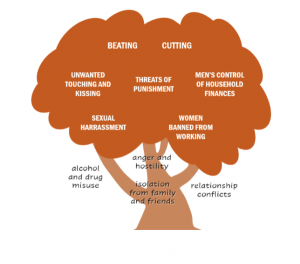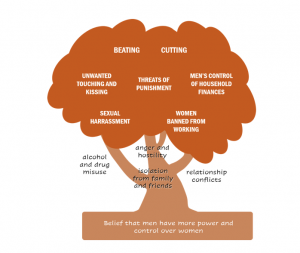Audience
Teens et Adults
Attendees
4+
Number of facilitators
1
Level
Advanced
Preparation
45 minutes
Activity
1 hour
Description
In this discussion-based activity, participants will learn how the root causes and risk factors for violence against women are connected using a problem tree diagram.
Objectives
By the end of this activity, participants will be able to describe the root cause of violence against women and girls.
Worked skills
Knowledge
Prerequisites for the audience
See VAWG curriculum schedule
Equipment
Flipchart paper, pens/pencils
Content used
None
Preparation
- To encourage honest discussion and learning in a safe environment, this activity should be delivered in single-sex groups; i.e., only to men or only to women. The facilitators should also be of the same sex as the participants in the group (i.e. women facilitators should facilitate activities among groups of women), especially for any sensitive discussions. This activity may be conducted with adolescents and youth, but considerations should be given toward conducting activities with individuals grouped by similar ages. It should be emphasized throughout the curriculum that violence should never be tolerated or accepted.
- This activity teaches more complex concepts than other activities in this kit. Review the activity and the tree diagrams carefully before facilitating this activity. Be prepared to teach the relationships between the root cause, risk factors for and examples of violence against women and girls. You can refer to the VAWG online course to help you prepare.
- This activity involves discussion of sensitive topics where participants may not all agree or may need time to consider the viewpoints shared. Expect to hear differing views of the subject and prepare to respond.
- Facilitators must be careful about how they lead the discussion. Make sure that no names are given to specific people who experience violence. This can put those people at greater risk of harm.

Figure 1
- Prepare a drawing of a tree on flipchart paper (The facilitator’s tree). (See example in the first diagram- Figure 1.) Be sure to include branches as well as the ground or roots. You will later write in the different parts of the tree (see the example in the third diagram – Figure 3), so be sure to leave enough space to write. If your participants would not benefit from the writing, you can still write on the tree to support your facilitation of discussion.
- Ask participants to sit in a circle facing the flipchart paper.
Introduction
- Tell participants, “In the previous activity, we discussed different types of violence against women. Today, we will discuss the causes of violence.”
- Tell participants, “Violence against women and girls is a complicated topic. Many researchers have studied why violence happens and how to reduce it. The information we present in this activity is the result of many years of research done in communities around the world.”
- Tell participants, “Problems are often much more complicated than they appear. What we think about as the cause of a problem is often not the main or root cause.”
- Pointing to the facilitator’s tree drawing, tell participants, “We can think about problems like this tree.”
- Pointing to the bunches of leaves, tell participants, “The leaves are the problems that we see.”
- Pointing to the branches that lead to the leaves, tell participants, “The branches are what we consider to be the causes.”
- Pointing to the roots, “However, many problems have a root cause. Like roots, these are causes that we can’t see.”
- Tell participants, “In this activity, we are going to think about violence in this way in order to understand the root cause of violence against women and girls.”
Discussion: Types of Violence Against Women and Girls
- Tell participants, “In the last activity, we discussed different types of violence. What are some examples we discussed?” Listen to a few responses and write on the tree leaves. Examples are shown in the second diagram. Be sure to use the examples given by the audience and that are relevant in your community.
- Now divide the group into smaller groups and give each group a flipchart paper with an empty tree drawing (Figure 1). Assign each group one of the types of violence. Ask the groups to write their type of violence on the tree leaves of their drawing.
- Pointing to the leaves, ask participants, “Thinking about these problems, why do you think they happen?”
- Ask participants to discuss the reasons for the type of violence shown in the tree. Ask each group to write the causes by the branches. Examples are shown in the second diagram (Figure 2).

Figure 2
Discussion: Root Causes of Violence Against Women and Girls
- Pointing to branches, tell participants, “Many of the reasons we think lead to violence are actually not the main or root cause of violence. These reasons make it more likely that women and girls would experience violence, but they are not the root cause.”
- Tell participants, “In a previous activity, we discussed gender boxes, the different expectations that society has of men and women. We discussed how society gives men more power by expecting them to lead and be in charge. Society expects men to provide and protect the family. Society expects men to be aggressive and women to be passive. Some men may interpret (or understand from) these expectations as they have the right to have control over women.”
- Ask the groups to write the root cause of violence at the base of their tree drawings. After discussing the groups’ response, at the base of the facilitators’ tree, write “Belief that men have more power and control over women.” See the example in the third drawing (Figure 3).

Figure 3
- Discuss with the participants, “The root cause of violence against women and girls is a belief that men have power and control over women. Violence is one way that men try to control women.” Give participants a few moments to think about the statement. Then ask participants if they agree or disagree with the idea that society’s belief is that men should control women. Thank them for their honesty when they respond.
Closing: Protecting Women and Girls from Violence
- Ask participants whether the forms of violence discussed are acceptable or unacceptable. Guide the discussion to reach an agreement that, “All forms of violence are an abuse of power and unacceptable.” Share with the group that, “In many countries, communities have worked to reduce violence against women and girls. They do this by introducing laws that make violence against women and girls a crime. Police and judges work together to respond to reported cases of violence and ensure that people who use violence are punished.”
- Ask participants, “What are the laws in this country that protect women and girls from violence?” Listen to a few responses and share some of the laws in the country regarding violence against women and girls if relevant.
- Tell participants, “There are other ways that women and girls can be protected from violence.” Ask participants to share some ideas. Examples of responses: giving more power to women, increasing access to education for girls as this allows them to be able to earn more money for the family.
- Discuss with participants, “Another way is to protect women and girls is by building relationships that are based on respect for one another, so that families can resolve conflicts peacefully. In this program, we learned different skills for improving communication. In the next activities, we will learn ways to resolve conflicts peacefully.”
- Thank participants for their honesty and openness in the discussion.
